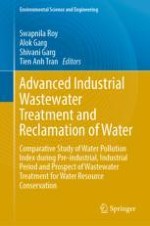2022 | OriginalPaper | Buchkapitel
12. Thermochemical Conversion of Biomass Waste to Amorphous Phase Carbon for Treating Industrial Waste Water
verfasst von : Shajalal Md Shibly, Zaira Zaman Chowdhury, Abu Nasser Mohammad Faisal, Ahmed Elsayid Ali, Arnab Barua, Rahman F. Rafique, Rabia Ikram, Rafie Bin Johan, Seeram Ramakrishnan
Erschienen in: Advanced Industrial Wastewater Treatment and Reclamation of Water
Aktivieren Sie unsere intelligente Suche, um passende Fachinhalte oder Patente zu finden.
Wählen Sie Textabschnitte aus um mit Künstlicher Intelligenz passenden Patente zu finden. powered by
Markieren Sie Textabschnitte, um KI-gestützt weitere passende Inhalte zu finden. powered by
